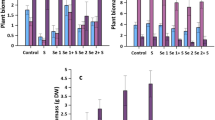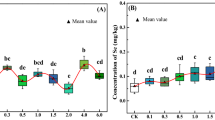Abstract
Buckwheat (Fagopyrum esculentum Moench) and quinoa (Chenopodium quinoa Willdenow) are widely used as food ingredients. The nutritional characteristics of these plants, i.e., high contents of proteins and amino acids suggest that selenium (Se) is preserved as selenoamino acid derivatives, in particular, selenomethionine (SeMet) in proteins, similar to selenized yeast. Therefore, buckwheat and quinoa are expected to be a good nutritional source of Se. Selenized buckwheat and quinoa were cultivated on Se-fortified soil using sparingly soluble Se salts, such as barium selenate and barium selenite. Se concentration in the edible parts of these plants was determined, and Se extraction efficiency with enzyme or alkali was evaluated. In addition, the chemical species of Se in the low molecular weight fraction of these plants were determined by HPLC-ICP-MS. Total Se concentrations in the edible parts of selenized buckwheat and quinoa were 170.4 ± 2.9 μg/g and 102.7 ± 2.4 μg/g wet weight, respectively. Thus, these selenized seeds were found to be Se accumulators. The results indicate that Se in selenized buckwheat exists mainly as SeMet, while Se in selenized quinoa exists not only as SeMet but also as selenate (Se(VI)) and non-protein forms.




Similar content being viewed by others
References
Rayman MP (2000) Lancet 356:233–241
Birringer M, Pilawa S, Flohe L (2002) Nat Prod Rep 19:693–718
Nomura AM, Lee J, Stemmermann GN, Combs GFJ (2000) Cancer Epidemiol Biomarkers Prev 9:883–887
Burke KE, Clive J, Combs GFJ, Nakamura RM (2003) J Am Acad Dermatol 49:458–472
Ip C, Birringer M, Block E, Kotrebai M, Tyson JF, Uden PC, Lisk DJ (2000) J Agric Food Chem 48:2062–2070
Whanger PD (2002) J Am Coll Nutr 21:223–232
Oshodi AA, Ogungbenle HN, Oladimeji MO (1999) Int J Food Sci Nutr 50:325–331
Skrabanja V, Liljeberg Elmståhl HG, Kreft I, Björck IM (2001) J Agric Food Chem 49:490–496
Schrauzer GN (2003) Adv Food Nutr Res 47:73–112
Stibilj V, Kreft I, Smrkolj P, Osvald J (2004) Eur Food Res Technol 219:142–144
Smrkolj P, Stibilj V, Kreft I, Germ M (2006) Food Chem 96:675–681
Suzuki KT (2005) J Health Sci 51:107–114
Łobiński R, Schaumlöffel D, Szpunar J (2006) Mass Spectrom Rev 25:255–289
Ogra Y, Suzuki KT (2005) J Anal At Spectrom 20:35–39
Ogra Y, Kitaguchi T, Ishiwata K, Iwashita Y, Suzuki N, Suzuki KT (2007) J Anal At Spectrom 22:1390–1396
Ogra Y, Ishiwata K, Iwashita Y, Suzuki KT (2005) J Chromatogr A 1093:118–125
Iwashita Y, Nishi K (2004) Biomed Res Trace Elements 15:72–75
Ogra Y, Ishiwata K, Suzuki KT (2005) Anal Chim Acta 554:123–129
Ogra Y, Ishiwata K, Ruiz-Encinar J, Łobinski R, Suzuki KT (2004) Anal Bioanal Chem 379:861–866
Dernovics M, Stefánka Z, Fodor P (2002) Anal Bioanal Chem 372:473–480
Połatajko A, Sliwka-Kaszynska M, Dernovics M, Ruzik R, Ruiz Encinar J, Szpunar J (2004) J Anal At Spectrom 19:114–120
Hinojosa Reyes L, Marchante-Gayon JM, Garcia Alonso JI, Sanz-Medel A (2006) J Agric Food Chem: 1557–1563
Kannamkumarath SS, Wrobel K, Wuilloud RG (2005) Talanta 66:153–159
Gergely V, Kubachka KM, Mounicou S, Fodor P, Caruso JA (2006) J Chromatogr A 1101:94–102
Yu F, Sheng J, Xu J, An X, Hu Q (2007) Eur Food Res Technol 225:843–848
Dumont E, Ogra Y, Vanhaecke F, Suzuki KT, Cornelis R (2006) Anal Bioanal Chem 384:1196–1206
Acknowledgments
We would like to acknowledge Grants-in-Aid from the Ministry of Education, Culture, Sports, Science and Technology, Japan (Nos. 16689005, 16209004, and 19390033), and the financial support from Agilent Technologies Foundation, USA. We also wish to thank Showa Denko for providing the HPLC system.
Author information
Authors and Affiliations
Corresponding author
Rights and permissions
About this article
Cite this article
Kitaguchi, T., Ogra, Y., Iwashita, Y. et al. Speciation of selenium in selenium-enriched seeds, buckwheat (Fagopyrum esculentum Moench) and quinoa (Chenopodium quinoa Willdenow). Eur Food Res Technol 227, 1455–1460 (2008). https://doi.org/10.1007/s00217-008-0866-2
Received:
Revised:
Accepted:
Published:
Issue Date:
DOI: https://doi.org/10.1007/s00217-008-0866-2




